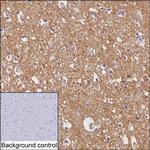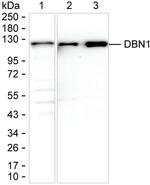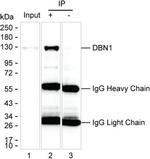Search Thermo Fisher Scientific
FIGURE: 1 / 3
Drebrin Antibody (MA5-55629) in IHC (P)



Product Details
MA5-55629
Species Reactivity
Host/Isotype
Class
Type
Clone
Immunogen
Conjugate
Form
Concentration
Purification
Storage buffer
Contains
Storage conditions
Shipping conditions
Product Specific Information
Sequence of this protein is as follows: LELLAAYEEV IREESAADWA LYTYEDGSDD LKLAASGEGG LQELSGHFEN QKVMYGFCSV KDSQAALPKY VLINWVGEDV PDARKCACAS HVAKVAEFFQ GVDVIVNASS VEDIDAGAIG QRLSNGLARL SSPVLHRLRL REDENAEPVG TTYQKTDAAV EMKRINREQF WEQAKKEEEL RKEEERKKAL DERLRFEQER MEQERQEQEE RERRYREREQ QIEEHRRKQQ TLEAEEAKRR LKEQSIFGDH RDEEEETHMK KSESEVEEAA AIIAQRPDNP REFFKQQERV ASASAGSCDV PSPFNHRPGS HLDSHRRMAP
Target Information
The protein encoded by this gene is a cytoplasmic actin-binding protein thought to play a role in the process of neuronal growth. It is a member of the drebrin family of proteins that are developmentally regulated in the brain. A decrease in the amount of this protein in the brain has been implicated as a possible contributing factor in the pathogenesis of memory disturbance in Alzheimer's disease. At least two alternative splice variants encoding different protein isoforms have been described for this gene.
For Research Use Only. Not for use in diagnostic procedures. Not for resale without express authorization.
References (0)
Bioinformatics
Protein Aliases: Developmentally-regulated brain protein; DKFZp434D064; Drebrin; drebrin A; drebrin E; drebrin E2; drebrin-1
Gene Aliases: D0S117E; DBN1; Drba
UniProt ID: (Human) Q16643, (Rat) Q07266, (Mouse) Q9QXS6
Entrez Gene ID: (Human) 1627, (Rat) 81653, (Mouse) 56320

Performance Guarantee
If an Invitrogen™ antibody doesn't perform as described on our website or datasheet,we'll replace the product at no cost to you, or provide you with a credit for a future purchase.*
Learn more
We're here to help
Get expert recommendations for common problems or connect directly with an on staff expert for technical assistance related to applications, equipment and general product use.
Contact tech support
